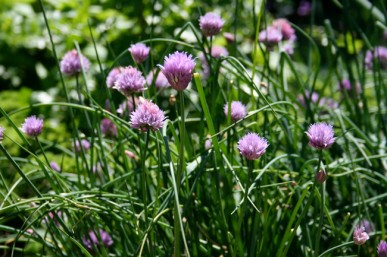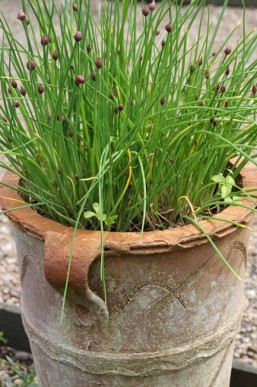Common onion chives (Allium schoenoprasum) are probably one of the most under-appreciated and most taken for granted herbs we grow. Instead of sulking in a corner because of their treatment, in my garden, the chives are powering ahead growing into dense clumps ready to flower in a month or so.
Chives grow in clumps of small white bulbs which send up soft tubular green leaves to 40 cm and, from early summer onwards, rounded heads of pinkish-purple flowers on stiff hollow stems.
Grow chives by sowing seed or by dividing clumps in spring. Dig clumps and reset every two to three years to keep the clumps healthy. Chives like regular top dressings of compost and plenty of water in summer to maintain healthy leaf growth. They have particularly well this year because of the winter rain. When harvesting, always leave about 5 cm of leaf above the bulb. Chives make a good edging plant, especially for the vegetable garden; they also grow well in a pot.
Chives are a classic culinary herb used for their sweet onion flavour in a range of dishes, especially omelettes and other egg dishes, salads and soups. I love them in sandwiches with cream cheese, or stirred through pasta with other herbs like parsley and winter cress. Chives are always added towards the end of cooking for maximum flavour. The pink buds and flowers are also edible, with a sweet subtle oniony flavour. Sprinkled over pumpkin soup they look sublime. Use them whole or pull the individual flowers from the head and sprinkle them over the dish just before serving. Medicinally chives are antibiotic and stimulate the appetite.
A spray made from chive leaves is mildly insect repellent, is a fungicide and is antiseptic. Plants scattered around the garden or grown near susceptible plants like roses will help to keep away some problem insects, such as aphids, borers and spider mites. Chive spray will also deter aphids. Try planting chives at the base of fruit trees to repel climbing insects and under apple and pear trees to prevent apple scab. With regular use chive spray will lessen the incidence of apple scab, black spot and curly leaf. The spray may also lessen the severity of an attack of downy or powdery mildew if applied regularly, while brown rot can be stopped from spreading by spraying every two days.
Recipe for chive spray. Pour 1L of boiling water over a firmly packed cupful of chopped leaves. Cover, cool, strain and use within a few hours.


